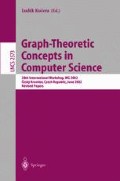Abstract
We investigate the computational complexity of a combinatorial problem that arises in DNA sequencing by hybridization: The input consists of an integer l together with a set S of words of length k over the four symbols A, C, G, T. The problem is to decide whether there exists a word of length l that contains every word in S at least once as a subword, and does not contain any other subword of length k. The computational complexity of this problem has been open for some time, and it remains open. What we prove is that this problem is polynomial time equivalent to the exact perfect matching problem in bipartite graphs, which is another infamous combinatorial optimization problem of unknown computational complexity.
Access this chapter
Tax calculation will be finalised at checkout
Purchases are for personal use only
Preview
Unable to display preview. Download preview PDF.
References
W. Bains and G.C. Smith [1988]. A novel method for nucleic acid sequence determination. Journal of Theoretical Biology 135, 303–307.
F. Barahona and W.R. Pulleyblank [1987]. Exact arborescences, matchings, and cycles. Discrete Applied Mathematics 16, 91–99.
C. Berge [1973]. Graphs and Hypergraphs. North Holland.
J. Błażewicz, P. Formanowicz, M. Kasprzak, W.T. Markiewicz, and J. Weglarz [1999]. DNA sequencing with positive and negative errors. Journal of Computational Biology 6, 113–123.
J. Błażewicz, A. Hertz, D. Kobler, and D. de Werra [1999]. On some properties of DNA graphs. Discrete Applied Mathematics 98, 1–19.
J. Błażewicz and M. Kasprzak [2001]. Complexity of DNA sequencing by hybridization. To appear in Theoretical Computer Science.
N.G. de Bruijn [1946]. A combinatorial problem. Koninklijke Nederlandse Akademie van Wetenschappen te Amsterdam. Proceedings 49, 758–764.
P. Erdos and R.L. Graham [1972]. On a linear diophantine problem of Frobenius. Acta Arithmetica 21, 399–408.
A.V. Karzanov [1987]. Maximum matching of given weight in complete and complete bipartite graphs. Cybernetics 23, 8–13; translation from Kibernetika 1, 1987, 7-11.
M. Leclerc [1986]. Polynomial time algorithms for exact matching problems. Master’s thesis, University of Waterloo, Waterloo.
M. Leclerc [1988/89]. Optimizing over a slice of the bipartite matching polytope. Discrete Mathematics 73, 159–162.
S. Martello and P. Toth [1990]. Knapsack problems: Algorithms and computer implementations. John Wiley & Sons.
K. Mulmuley, U. Vazirani, and V.V. Vazirani [1987]. Matching is as easy as matrix inversion. Combinatorica 7, 105–113.
C.H. Papadimitriou and M. Yannakakis [1982]. The complexity of restricted spanning tree problems. Journal of the ACM 29, 285–309.
P.A. Pevzner [1989]. l-tuple DNA sequencing: Computer analysis. Journal of Biomolecular Structure and Dynamics 7, 63–73.
Author information
Authors and Affiliations
Editor information
Editors and Affiliations
Rights and permissions
Copyright information
© 2002 Springer-Verlag Berlin Heidelberg
About this paper
Cite this paper
Błażewicz, J., Formanowicz, P., Kasprzak, M., Schuurman, P., Woeginger, G.J. (2002). DNA Sequencing, Eulerian Graphs, and the Exact Perfect Matching Problem. In: Goos, G., Hartmanis, J., van Leeuwen, J., Kučera, L. (eds) Graph-Theoretic Concepts in Computer Science. WG 2002. Lecture Notes in Computer Science, vol 2573. Springer, Berlin, Heidelberg. https://doi.org/10.1007/3-540-36379-3_2
Download citation
DOI: https://doi.org/10.1007/3-540-36379-3_2
Published:
Publisher Name: Springer, Berlin, Heidelberg
Print ISBN: 978-3-540-00331-1
Online ISBN: 978-3-540-36379-8
eBook Packages: Springer Book Archive

